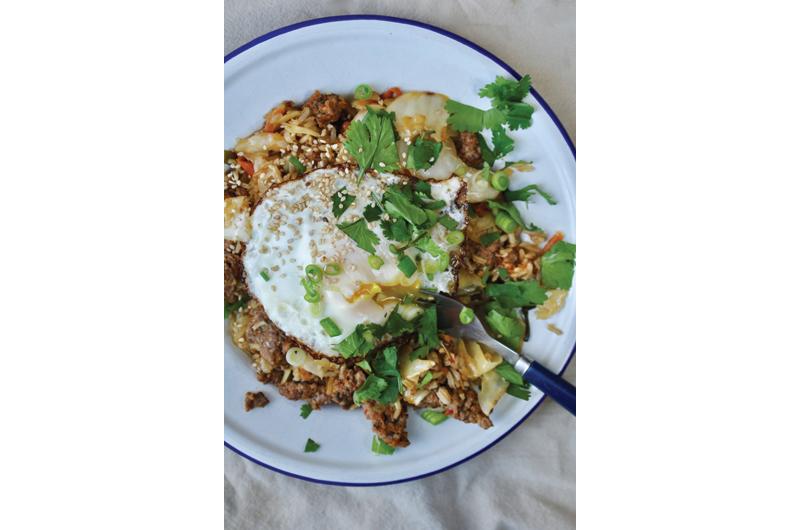I am a little late to the game, but this winter, after being a longtime admirer from afar, I dove into the world of kimchi. Looking back, this was an inevitable fate. The traditional fermented Korean vegetable side dish was a hot topic of conversation among my health-nut friends, and was popping up on local menus and in kitchens all across this Island.
For me, it all started with a delicious lunch of kimchi pancakes at the Mangku Food Truck, parked next to the Capawock Theatre, last fall. The thin vegetable pancakes were fried until crisp with a satisfying sweet-and-sour kick. Just a few days later, I overheard a passionate discussion at Morrice Florist about where to store pungent-smelling homemade kimchi, and a debate over the perfect level of chili. Riding the kimchi wave, I woke up the next day faced with the task of picking a potluck dish and chose a recipe for kimchi fried rice from Julia Turshen’s new cookbook Small Victories. It was time to stop being a bystander and bring some kimchi into my own kitchen. This felt like a safe place to start.
I headed out and bought a few jars of MV Kimchi, a small-batch product made by Jei Thayer from her home in Vineyard Haven. MV Kimchi is a blend of napa cabbage, scallion, hot pepper, ginger, garlic, and salt. Thayer has been making kimchi for forty years, having first learned the process in her grandmother’s Korean kitchen. You can find her small batch kimchi at The Net Result, Ghost Island Farm, and Vineyard Grocer.

Being the curious home cook (a.k.a. food geek) that I am, I wanted to know more about kimchi before cooking and serving it. Here is what I learned. Kimchi is a traditional fermented Korean condiment made with vegetables and a variety of seasonings. People have been making kimchi for a long time, ever since chili peppers were first introduced to Korea in the mid-Joseon era (1392–1897). There are hundreds of varieties of kimchi made from a host of vegetables, including napa cabbage, radish, scallion, garlic, ginger, and cucumber. Most kimchi is made by lacto-fermentation, the same process that creates sauerkraut and traditional dill pickles. In the first stage, the cabbage (or other vegetables) are soaked in a salty brine that kills off harmful bacteria. In the second stage, the remaining lactobacillus bacteria (the good guys!) convert sugars into lactic acid, which preserves the vegetables and gives them that wonderful, tangy flavor. Historically, kimchi is stored underground in jars to keep cool and unfrozen during the winter months.
It’s this lacto-fermentation that makes kimchi “one of the world’s healthiest foods.” The healthy bacteria that comes from the fermentation process helps fight infection, boosts the immune system, reduces the risk of cancer, and offers anti-inflammatory and cholesterol-reducing properties. Kimchi is also loaded with dietary fiber, which makes us feel full, but one cup has just twenty-two calories.
After my quick history lesson, I was ready to crack open a jar and play around. While dreaming up ways to incorporate kimchi into my seasonal kitchen, it dawned on me that the Island’s love of local produce, its experimental food culture, and do-it-yourself attitude is a perfect match for kimchi. Like us Islanders who try to eat according to the seasons, Koreans make different types of kimchi at different times of the year, based on what is growing outside. Summer kimchi blends often use radishes and cucumbers, while fall and winter batches are built with cabbage. Although kimchi doesn’t sound like a local dish, the base of cabbage, carrots, scallions, and herbs all grow right outside our Massachusetts doors.
First inspired by Turshen’s simple kimchi fried rice recipe, I now find myself making my own version of Kimchi Fried Rice Bowls with Local Pork & Eggs for lunch and weekend brunch. Kimchi rice bowls are a great place to start for those of you new to fermented vegetables. The ingredients are simple (rice, veggies, eggs, pork) and can be tweaked to match your personal preferences. There is really no wrong way to enjoy kimchi – it works perfectly added to stews, stir-fries, scrambled eggs, atop baked sweet potatoes, or mixed in with sautéed greens. Of course, it can be eaten on its own as well. Island markets sell a variety of kimchi, but if you ask around, you’re sure to find a friend or neighbor making kimchi at home.
I don’t know if Vineyarders will ever match the forty pounds of kimchi enjoyed annually per person in South Korea, but I do hope we all spend some time with this fascinating food and see that kimchi is more familiar to us then we might think.
The following recipe was originally published along with this article:
Kimchi Fried Rice Bowls with Local Pork & Eggs






